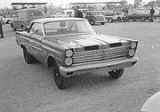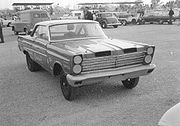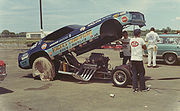
Funny Car
Encyclopedia



Drag racing
Drag racing is a competition in which specially prepared automobiles or motorcycles compete two at a time to be the first to cross a set finish line, from a standing start, in a straight line, over a measured distance, most commonly a ¼-mile straight track....
car class. In the United States, other "professional" classes are Top Fuel
Top Fuel
Top Fuel racing is a class of drag racing in which the cars are run on a mix of approximately 90% nitromethane and 10% methanol rather than gasoline or simply methanol. The cars are purpose-built for drag racing, with an exaggerated layout that in some ways resembles open-wheel circuit racing...
, Pro Stock
Pro Stock
Pro Stock Drag Racing is a class of drag racing featuring 'Factory Hot-Rods'. The class can be known as "all motor," as the cars cannot use artificial induction such as turbocharging, supercharging, or nitrous oxide, and there are very strict rules governing the modifications allowed to the...
, and Pro Stock Motorcycle. Funny cars have forward-mounted engines and carbon fiber
Carbon fiber
Carbon fiber, alternatively graphite fiber, carbon graphite or CF, is a material consisting of fibers about 5–10 μm in diameter and composed mostly of carbon atoms. The carbon atoms are bonded together in crystals that are more or less aligned parallel to the long axis of the fiber...
automotive bodies over the chassis, giving them an appearance vaguely approximating manufacturers' showroom models. The Dodge Charger
Dodge Charger
The Dodge Charger is an American automobile manufactured by the Dodge division of Chrysler. There have been several different Dodge vehicles, built on three different platforms and sizes, all bearing the Charger nameplate...
and Chevrolet Impala
Chevrolet Impala
The Chevrolet Impala is a full-size automobile built by the Chevrolet division of General Motors introduced for the 1958 model year. Deriving its name from the southern African antelope, Chevrolet's most expensive passenger model through 1965 had become the best-selling automobile in the United...
sedans, along with the Ford Mustang
Ford Mustang
The Ford Mustang is an automobile manufactured by the Ford Motor Company. It was initially based on the second generation North American Ford Falcon, a compact car. Introduced early on April 17, 1964, as a "1964½" model, the 1965 Mustang was the automaker's most successful launch since the Model A...
and Toyota Solara coupe, are now commonly used in the National Hot Rod Association (NHRA). Worldwide, however, many different body styles are used. These "fake" body shells are not just cosmetic: they serve an important aerodynamic purpose.
Guidelines
The NHRA has strict guidelines for funny cars. Most of the rules relate to the engine. In short, the engines can only be V-8V8 engine
A V8 engine is a V engine with eight cylinders mounted on the crankcase in two banks of four cylinders, in most cases set at a right angle to each other but sometimes at a narrower angle, with all eight pistons driving a common crankshaft....
s displacing no more than 500 cubic inches (8.19 L). (The most popular design is loosely based on the Chrysler 426 Hemi
Chrysler Hemi engine
The Chrysler Hemi engine, known by the trademark Hemi, is a series of V8 engines built by Chrysler with a hemispherical combustion chamber. Three different types of Hemi engines have been built by Chrysler for automobiles: the first from 1951–1958, the second from 1964–1971, and the third...
.) There can only be two valves
Poppet valve
A poppet valve is a valve consisting of a hole, usually round or oval, and a tapered plug, usually a disk shape on the end of a shaft also called a valve stem. The shaft guides the plug portion by sliding through a valve guide...
per cylinder
Cylinder (engine)
A cylinder is the central working part of a reciprocating engine or pump, the space in which a piston travels. Multiple cylinders are commonly arranged side by side in a bank, or engine block, which is typically cast from aluminum or cast iron before receiving precision machine work...
. The heads are machined from a solid block of billet aluminum and have no water jackets, as the high latent heat of the methanol in the fuel coupled with the brevity of the run precludes the need for water cooling of the cylinder heads. Supercharger
Supercharger
A supercharger is an air compressor used for forced induction of an internal combustion engine.The greater mass flow-rate provides more oxygen to support combustion than would be available in a naturally aspirated engine, which allows more fuel to be burned and more work to be done per cycle,...
s are restricted to a basic Roots
Roots type supercharger
The Roots type supercharger or Roots blower is a positive displacement lobe pump which operates by pumping fluids with a pair of meshing lobes not unlike a set of stretched gears. Fluid is trapped in pockets surrounding the lobes and carried from the intake side to the exhaust...
type—19 inches (482.6 mm) rotor case width with a breadth of 11.25 inches (285.8 mm). The rotors are not allowed to have more than a certain amount of helical twist in them so the blower does not become a screw-type supercharger in function. Only single camshaft
Camshaft
A camshaft is a shaft to which a cam is fastened or of which a cam forms an integral part.-History:An early cam was built into Hellenistic water-driven automata from the 3rd century BC. The camshaft was later described in Iraq by Al-Jazari in 1206. He employed it as part of his automata,...
s are allowed. There are two common bore-stroke combinations: 4.1875 × (called a 3/4 stroker) and 4.25 × (called a 5/8 stroker). The 3/4 stroker is the most common combination used today and equals 496 CID (8.1 L).
Engine blocks are usually made out of billet
Billet (manufacturing)
Semi-finished casting products are intermediate castings produced in a foundry that need further processing before being a finished good. There are four types: ingots, billets, blooms, and slabs.-Ingot:...
. Crankshaft
Crankshaft
The crankshaft, sometimes casually abbreviated to crank, is the part of an engine which translates reciprocating linear piston motion into rotation...
s are CNC machine carved from a single piece of steel billet then nitrided in an oven to increase surface hardness. Intake valves are titanium
Titanium
Titanium is a chemical element with the symbol Ti and atomic number 22. It has a low density and is a strong, lustrous, corrosion-resistant transition metal with a silver color....
and of 2.4 inches (61 mm) width, while exhaust valves are 1.9 inches (48.3 mm) width of Inconel
Inconel
Inconel is a registered trademark of Special Metals Corporation that refers to a family of austenitic nickel-chromium-based superalloys. Inconel alloys are typically used in high temperature applications. It is often referred to in English as "Inco"...
. Every funny car has ballistic blankets covering specific parts of the engine prone to explosion, namely the supercharger.
Funny car fuel systems are key to their immense power. During a single run (starting, burnout, backing up, staging, 1/4 mile) cars can burn as much as 15 US gal (12.5 imp gal; 56.8 l) of fuel. The fuel mixture is usually 85–90% nitromethane
Nitromethane
Nitromethane is an organic compound with the chemical formula . It is the simplest organic nitro compound. It is a slightly viscous, highly polar liquid commonly used as a solvent in a variety of industrial applications such as in extractions, as a reaction medium, and as a cleaning solvent...
with 10–15% methanol
Methanol
Methanol, also known as methyl alcohol, wood alcohol, wood naphtha or wood spirits, is a chemical with the formula CH3OH . It is the simplest alcohol, and is a light, volatile, colorless, flammable liquid with a distinctive odor very similar to, but slightly sweeter than, ethanol...
. The ratio of fuel to air can be as high as 1:1. Compression ratio
Compression ratio
The 'compression ratio' of an internal-combustion engine or external combustion engine is a value that represents the ratio of the volume of its combustion chamber from its largest capacity to its smallest capacity...
s vary from 6:1 to 7:1. The engines in funny cars commonly exhibit varying piston
Piston
A piston is a component of reciprocating engines, reciprocating pumps, gas compressors and pneumatic cylinders, among other similar mechanisms. It is the moving component that is contained by a cylinder and is made gas-tight by piston rings. In an engine, its purpose is to transfer force from...
heights and ratios that are determined by the piston's proximity to the air intake. Funny cars have a fixed gear ratio
Gear ratio
The gear ratio of a gear train is the ratio of the angular velocity of the input gear to the angular velocity of the output gear, also known as the speed ratio of the gear train. The gear ratio can be computed directly from the numbers of teeth of the various gears that engage to form the gear...
of 3.20:1 and have a reversing gear; power is transmitted from engine to final drive through a multiple staged clutch which provides progressive incremental lockup as the run proceeds. The rate/degree of lockup is mechanically/pneumatically controlled and preset before each run according to various conditions, in particular track surface. Wheelbase
Wheelbase
In both road and rail vehicles, the wheelbase is the distance between the centers of the front and rear wheels.- Road :In automobiles, the wheelbase is the horizontal distance between the center of the front wheel and the center of the rear wheel...
is between 100 and 125 in (2.5 and 3.2 m). The car must maintain a 3 inches (76.2 mm) ground clearance.
Horsepower claims vary widely—from 6,978 to 8,897—but are probably around 8,000 HP
Horsepower
Horsepower is the name of several units of measurement of power. The most common definitions equal between 735.5 and 750 watts.Horsepower was originally defined to compare the output of steam engines with the power of draft horses in continuous operation. The unit was widely adopted to measure the...
. Supercharged, nitromethane-fueled motors of this type derive their extremely high speeds from their torque
Torque
Torque, moment or moment of force , is the tendency of a force to rotate an object about an axis, fulcrum, or pivot. Just as a force is a push or a pull, a torque can be thought of as a twist....
, which is estimated at about 7000 ft.lbf. They routinely achieve a 6G
G-force
The g-force associated with an object is its acceleration relative to free-fall. This acceleration experienced by an object is due to the vector sum of non-gravitational forces acting on an object free to move. The accelerations that are not produced by gravity are termed proper accelerations, and...
acceleration from a standing start.
Safety
Many safety rules are in place to protect the driver and fans. The more visible accoutrements are the twin parachuteParachute
A parachute is a device used to slow the motion of an object through an atmosphere by creating drag, or in the case of ram-air parachutes, aerodynamic lift. Parachutes are usually made out of light, strong cloth, originally silk, now most commonly nylon...
s to help stabilize and decelerate the car after crossing the finish line.
During safety evaluations in the wake of the fatal crash of Scott Kalitta
Scott Kalitta
Scott Kalitta was an American drag racer who competed in the Funny Car and Top Fuel classes in the National Hot Rod Association Full Throttle Drag Racing Series. He was killed at Old Bridge Township Raceway Park, after an accident during qualifying...
on June 21, 2008 in Englishtown, N.J., the NHRA reduced the distance of Top Fuel and Funny Car races to 1,000 feet effective July 2, 2008. Pro Stock and sportsman classes still race to 1,320 feet.
Origins and name
The first funny cars were built in the mid-'60s and so-called because the rear wheels had been moved forward on the chassis to improve weight transfer under acceleration, increasing traction on the rear tires, which were oversized compared to stock. Looking at the cars, they didn't quite look stock, hence the name "funny." Many of the older cars are still raced today in the NHRA Heritage Hot Rod Racing Series, including the National Hot Rod Reunion and the California Hot Rod Reunion.NHRA Top Fuel Funny Car champions (1974–2011)
- 1974 - Shirl Greer
- 1975 - Don PrudhommeDon PrudhommeDon 'The Snake' Prudhomme, is an American drag racer.-Racing career:In 1962, Prudhomme was a partner in the Greer-Black-Prudhomme digger, which earned the best win record in NHRA history, before switching to Funny Car. He would win the NHRA FC championship four times in his thirty-five-year career...
- 1976 - Don Prudhomme
- 1977 - Don Prudhomme
- 1978 - Don Prudhomme
- 1979 - Raymond BeadleRaymond BeadleRaymond Beadle was an American nitro funny car and dragster racer, as well as a prolific auto racing team owner.In the sport of drag racing, Beadle's 'Blue Max' cars he won three consecutive NHRA funny car championships from 1979 to 1981 and three IHRA funny car championships - 1975-6 and 1981.In...
- 1980 - Raymond Beadle
- 1981 - Raymond Beadle
- 1982 - Frank Hawley
- 1983 - Frank Hawley
- 1984 - Mark Oswald
- 1985 - Kenny BernsteinKenny BernsteinKenny Bernstein is an American drag racer and former NASCAR and IndyCar team owner. He is nicknamed the "Bud King" for his success in the Budweiser King dragster, he has also been nicknamed "The King of Speed," because he was the first driver to break 300 miles per hour in the standing-start...
- 1986 - Kenny Bernstein
- 1987 - Kenny Bernstein
- 1988 - Kenny Bernstein
- 1989 - Bruce Larson
- 1990 - John ForceJohn ForceJohn Harold Force is an NHRA drag racer, a 15-time Funny Car champion driver, and a 17-time champion car owner. Force owns and drives for John Force Racing. He is one of the most dominant drag racers in the sport with 133 career victories...
- 1991 - John Force
- 1992 - Cruz Pedregon
- 1993 - John Force
- 1994 - John Force
- 1995 - John Force
- 1996 - John Force
- 1997 - John Force
- 1998 - John Force
- 1999 - John Force
- 2000 - John Force
- 2001 - John Force
- 2002 - John Force
- 2003 - Tony Pedregon
- 2004 - John Force
- 2005 - Gary Scelzi
- 2006 - John Force
- 2007 - Tony Pedregon
- 2008 - Cruz Pedregon
- 2009 - Robert Hight
- 2010 - John Force
- 2011 - Matt Hagan

